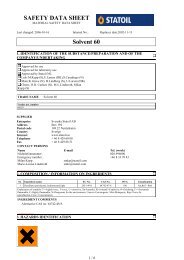Material Safety Data Sheet - IQ Logistics
Material Safety Data Sheet - IQ Logistics
Material Safety Data Sheet - IQ Logistics
You also want an ePaper? Increase the reach of your titles
YUMPU automatically turns print PDFs into web optimized ePapers that Google loves.
<strong>Safety</strong> <strong>Data</strong> <strong>Sheet</strong><br />
SECTION 1 PRODUCT AND COMPANY IDENTIFICATION<br />
OGA 72017<br />
Product Use:<br />
Gasoline fuel additive<br />
Company Identification<br />
Chevron Oronite S. A.<br />
79 Rue Anatole France<br />
92309<br />
Levallois Perret Cedex<br />
France<br />
Transportation Emergency Response<br />
Australia: Oronite Australia 1 800 009 010<br />
Asia: ChevronTexaco Emergency Information Centre +(1) 510-231-0623<br />
Europe: Oronite SA - Gonfreville Plant (33) 2 35 25 55 00<br />
North America: CHEMTREC (800) 424-9300 or (703) 527-3887<br />
South America: Chevron Oronite Brasil Ltda (24 hours) 55 11 4478-1200<br />
Health Emergency<br />
USA: International collect calls accepted 24 hours (800) 231-0623 or (510) 231-0623<br />
Product Information<br />
Technical Information: 01 46 39 36 00<br />
D-Tect®, OLOA®, OGA®, OFA®, ODA®, PARATONE®, and TFA® are registered trademarks of the<br />
Chevron Oronite Company, LLC.<br />
SECTION 2 COMPOSITION/ INFORMATION ON INGREDIENTS<br />
COMPONENTS EC NUMBER SYMBOL / RISK AMOUNT<br />
PHRASES<br />
Alkarylpolyether amine Polymer R53 63 %weight<br />
Branched chain alkaryl hydrocarbon 272-258-4 Xn/R65, R67, 33 %weight<br />
N/R51/53<br />
Branched alkanol Confidential R18, Xn/R22, 2 %weight<br />
Xi/R36/37/38, R67,<br />
R52/53<br />
Solvent naphtha (petroleum), heavy aromatic 265-198-5 Xn/R65, R66, R67,<br />
N/R51/53<br />
0.7 %weight<br />
The full text of all R-phrases is shown in Section 16.<br />
SECTION 3 HAZARDS IDENTIFICATION<br />
CLASSIFICATION: R67 | N; R51/53 |<br />
IMMEDIATE HEALTH EFFECTS<br />
____________________________________________________________________<br />
Revision Number: 0<br />
Revision Date: APRIL 13, 2005<br />
1 of 6 OGA 72017<br />
MSDS : 14031
Eye: Not expected to cause prolonged or significant eye irritation.<br />
Skin: Contact with the skin is not expected to be harmful.<br />
Ingestion: Not expected to be harmful if swallowed.<br />
Inhalation: Excessive or prolonged breathing of this material may cause central nervous system effects.<br />
Central nervous system effects may include headache, dizziness, nausea, vomiting, weakness, loss of<br />
coordination, blurred vision, drowsiness, confusion, or disorientation. At extreme exposures, central<br />
nervous system effects may include respiratory depression, tremors or convulsions, loss of<br />
consciousness, coma or death.<br />
DELAYED OR OTHER HEALTH EFFECTS: Not classified.<br />
ENVIRONMENTAL EFFECTS: Toxic to aquatic organisms, may cause long-term adverse effects in the<br />
aquatic environment.<br />
SECTION 4 FIRST AID MEASURES<br />
Eye: No specific first aid measures are required. As a precaution, remove contact lenses, if worn, and<br />
flush eyes with water.<br />
Skin: No specific first aid measures are required. As a precaution, remove clothing and shoes if<br />
contaminated. To remove the material from skin, apply a waterless hand cleaner, mineral oil, or<br />
petroleum jelly. Then wash with soap and water. Discard contaminated clothing and shoes or thoroughly<br />
clean before reuse.<br />
Ingestion: No specific first aid measures are required. Do not induce vomiting. As a precaution, get<br />
medical advice.<br />
Inhalation: Move the exposed person to fresh air. If not breathing, give artificial respiration. If breathing<br />
is difficult, give oxygen. Get medical attention if breathing difficulties continue.<br />
SECTION 5 FIRE FIGHTING MEASURES<br />
FLAMMABLE PROPERTIES:<br />
Flashpoint: (Pensky-Martens Closed Cup) 62 °C (144 °F) Minimum<br />
Autoignition: No <strong>Data</strong> Available<br />
Flammability (Explosive) Limits (% by volume in air): Lower: No data available Upper: No data<br />
available<br />
EXTINGUISHING MEDIA: Use water fog, foam, dry chemical or carbon dioxide (CO2) to extinguish<br />
flames.<br />
PROTECTION OF FIRE FIGHTERS:<br />
Fire Fighting Instructions: This material will burn although it is not easily ignited. For fires involving this<br />
material, do not enter any enclosed or confined fire space without proper protective equipment, including<br />
self-contained breathing apparatus.<br />
Combustion Products: Highly dependent on combustion conditions. A complex mixture of airborne<br />
solids, liquids, and gases including carbon monoxide, carbon dioxide, and unidentified organic<br />
compounds will be evolved when this material undergoes combustion.<br />
SECTION 6 ACCIDENTAL RELEASE MEASURES<br />
Protective Measures: Eliminate all sources of ignition in vicinity of spilled material.<br />
Spill Management: Stop the source of the release if you can do it without risk. Contain release to<br />
prevent further contamination of soil, surface water or groundwater. Clean up spill as soon as possible,<br />
observing precautions in Exposure Controls/Personal Protection. Use appropriate techniques such as<br />
applying non-combustible absorbent materials or pumping. Where feasible and appropriate, remove<br />
____________________________________________________________________<br />
Revision Number: 0<br />
Revision Date: APRIL 13, 2005<br />
2 of 6 OGA 72017<br />
MSDS : 14031
contaminated soil. Place contaminated materials in disposable containers and dispose of in a manner<br />
consistent with applicable regulations.<br />
Reporting: Report spills to local authorities as appropriate or required.<br />
SECTION 7 HANDLING AND STORAGE<br />
Specific Use: Gasoline fuel additive<br />
Precautionary Measures: Do not get in eyes, on skin, or on clothing. Do not breathe vapor or fumes.<br />
Wash thoroughly after handling.<br />
General Handling Information: The recommended handling temperature is ambient temperature.<br />
Avoid contaminating soil or releasing this material into sewage and drainage systems and bodies of<br />
water.<br />
Static Hazard: Electrostatic charge may accumulate and create a hazardous condition when handling<br />
this material. To minimize this hazard, bonding and grounding may be necessary but may not, by<br />
themselves, be sufficient. Review all operations which have the potential of generating and accumulating<br />
an electrostatic charge and/or a flammable atmosphere (including tank and container filling, splash filling,<br />
tank cleaning, sampling, gauging, switch loading, filtering, mixing, agitation, and vacuum truck operations)<br />
and use appropriate mitigating procedures.<br />
General Storage Information: In normal storage conditions, the shelf life of this product is 1 year.<br />
Container Warnings: Container is not designed to contain pressure. Do not use pressure to empty<br />
container or it may rupture with explosive force. Empty containers retain product residue (solid, liquid,<br />
and/or vapor) and can be dangerous. Do not pressurize, cut, weld, braze, solder, drill, grind, or expose<br />
such containers to heat, flame, sparks, static electricity, or other sources of ignition. They may explode<br />
and cause injury or death. Empty containers should be completely drained, properly closed, and promptly<br />
returned to a drum reconditioner or disposed of properly.<br />
SECTION 8 EXPOSURE CONTROLS/PERSONAL PROTECTION<br />
GENERAL CONSIDERATIONS:<br />
Consider the potential hazards of this material (see Section 3), applicable exposure limits, job activities,<br />
and other substances in the work place when designing engineering controls and selecting personal<br />
protective equipment. If engineering controls or work practices are not adequate to prevent exposure to<br />
harmful levels of this material, the personal protective equipment listed below is recommended. The user<br />
should read and understand all instructions and limitations supplied with the equipment since protection is<br />
usually provided for a limited time or under certain circumstances. Refer to appropriate CEN standards.<br />
ENGINEERING CONTROLS:<br />
If user operations generate airborne material, use process enclosures, local exhaust ventilation, or other<br />
engineering controls to control exposure.<br />
PERSONAL PROTECTIVE EQUIPMENT<br />
Eye/Face Protection: No special eye protection is normally required. Where splashing is possible, wear<br />
safety glasses with side shields as a good safety practice.<br />
Skin Protection: No special protective clothing is normally required. Where splashing is possible, select<br />
protective clothing depending on operations conducted, physical requirements and other substances in<br />
the workplace. Suggested materials for protective gloves include: Nitrile Rubber.<br />
Respiratory Protection: If exposure to harmful levels of airborne material may occur when working with<br />
this material, wear an approved respirator that provides protection, such as: Air-Purifying Respirator for<br />
Organic Vapors.<br />
Use a positive pressure air-supplying respirator in circumstances where air-purifying respirators may not<br />
provide adequate protection.<br />
No applicable occupational exposure limits exist for this material or its components. Consult local<br />
authorities for appropriate values.<br />
____________________________________________________________________<br />
Revision Number: 0<br />
Revision Date: APRIL 13, 2005<br />
3 of 6 OGA 72017<br />
MSDS : 14031
SECTION 9 PHYSICAL AND CHEMICAL PROPERTIES<br />
Attention: the data below are typical values and do not constitute a specification.<br />
Color: No <strong>Data</strong> Available<br />
Physical State: Liquid<br />
Odor: Hydrocarbon odor<br />
pH: Not Applicable<br />
Vapor Pressure: No data available<br />
Vapor Density (Air = 1): No data available<br />
Boiling Point: No <strong>Data</strong> Available<br />
Solubility: Insoluble in water.<br />
Freezing Point: No <strong>Data</strong> Available<br />
Specific Gravity: 0.938 @ 15°C (59°F)<br />
Density: No <strong>Data</strong> Available<br />
Viscosity: 28 mm2/s @ 40°C (104°F)<br />
SECTION 10 STABILITY AND REACTIVITY<br />
Chemical Stability: This material is considered stable under normal ambient and anticipated storage<br />
and handling conditions of temperature and pressure.<br />
Conditions to Avoid: Open flames, sparks, temperatures above the material flash point.<br />
Incompatibility With Other <strong>Material</strong>s: May react with strong acids or strong oxidizing agents, such as<br />
chlorates, nitrates, peroxides, etc.<br />
Hazardous Polymerization: Hazardous polymerization will not occur.<br />
SECTION 11 TOXICOLOGICAL INFORMATION<br />
IMMEDIATE HEALTH EFFECTS<br />
Eye Irritation: The eye irritation hazard is based on evaluation of data for similar materials or product<br />
components.<br />
Skin Irritation: The skin irritation hazard is based on evaluation of data for similar materials or product<br />
components.<br />
Skin Sensitization: The skin sensitization hazard is based on evaluation of data for similar materials or<br />
product components.<br />
Acute Dermal Toxicity: The acute dermal toxicity hazard is based on evaluation of data for similar<br />
materials or product components.<br />
Acute Oral Toxicity: The acute oral toxicity hazard is based on evaluation of data for similar materials or<br />
product components.<br />
Acute Inhalation Toxicity: The acute inhalation toxicity hazard is based on evaluation of data for similar<br />
materials or product components.<br />
SECTION 12 ECOLOGICAL INFORMATION<br />
ECOTOXICITY<br />
This material is expected to be toxic to aquatic organisms. The product has not been tested. The<br />
statement has been derived from the properties of the individual components.<br />
MOBILITY<br />
____________________________________________________________________<br />
Revision Number: 0<br />
Revision Date: APRIL 13, 2005<br />
4 of 6 OGA 72017<br />
MSDS : 14031
No data available.<br />
PERSISTENCE AND DEGRADABILITY<br />
May cause long-term adverse effects in the aquatic environment. The product has not been tested. The<br />
statement has been derived from the properties of the individual components.<br />
POTENTIAL TO BIOACCUMULATE<br />
Bioconcentration Factor: No data available.<br />
Octanol/Water Partition Coefficient: No <strong>Data</strong> Available<br />
SECTION 13 DISPOSAL CONSIDERATIONS<br />
Use material for its intended purpose or recycle if possible. This material, if it must be discarded, may<br />
meet the criteria of a hazardous waste as defined by international, country, or local laws and regulations.<br />
In accordance with European Waste Catalogue (E.W.C.) the codification is the following: 07 07 99.<br />
SECTION 14 TRANSPORT INFORMATION<br />
The description shown may not apply to all shipping situations. Consult appropriate Dangerous Goods<br />
Regulations for additional description requirements (e.g., technical name) and mode-specific or quantityspecific<br />
shipping requirements.<br />
ADR/RID Shipping Description: UN3082 ENVIRONMENTALLY HAZARDOUS SUBSTANCE, L<strong>IQ</strong>UID,<br />
N.O.S. (BRANCHED CHAIN ALKARYL HYDROCARBON, PETROLEUM HEAVY AROMATIC SOLVENT<br />
NAPHTHA), 9, III , Hazard ID No.90<br />
ICAO/IATA Shipping Description: UN3082 ENVIRONMENTALLY HAZARDOUS SUBSTANCE,<br />
L<strong>IQ</strong>UID, N.O.S. (BRANCHED CHAIN ALKARYL HYDROCARBON, PETROLEUM HEAVY AROMATIC<br />
SOLVENT NAPHTHA), 9, III<br />
IMO/IMDG Shipping Description: UN3082 ENVIRONMENTALLY HAZARDOUS SUBSTANCE, L<strong>IQ</strong>UID,<br />
N.O.S. (BRANCHED CHAIN ALKARYL HYDROCARBON, PETROLEUM HEAVY AROMATIC<br />
SOLVENT NAPHTHA), 9, III<br />
SECTION 15 REGULATORY INFORMATION<br />
REGULATORY LISTS SEARCHED:<br />
01=EU. Directive 76/769/EEC: Restrictions on the marketing and use of certain dangerous substances.<br />
02=EU Directive 90/394/EEC: Carcinogens at work.<br />
03=EU Directive 92/85/EEC: Pregnant or breastfeeding workers.<br />
04=EU Directive 96/82/EC (Seveso II): Article 9.<br />
05=EU Directive 96/82/EC (Seveso II): Articles 6 and 7.<br />
06=EU Directive 98/24/EC: Chemical agents at work.<br />
07=France INRS, Maladies Professionelles<br />
The following components of this material are found on the regulatory lists indicated.<br />
Solvent naphtha (petroleum), heavy aromatic 06<br />
CHEMICAL INVENTORIES:<br />
All components comply with the following chemical inventory requirements: DSL (Canada), EINECS<br />
(European Union), IECSC (China), KECI (Korea), PICCS (Philippines), TSCA (United States).<br />
One or more components does not comply with the following chemical inventory requirements: AICS<br />
____________________________________________________________________<br />
Revision Number: 0<br />
Revision Date: APRIL 13, 2005<br />
5 of 6 OGA 72017<br />
MSDS : 14031
(Australia), ENCS (Japan).<br />
COUNTRY REGISTRATION:<br />
Switzerland: No<br />
CLASSIFICATION - LABELING:<br />
Under the criteria of the directive EEC/67/548 (dangerous substances) and EEC/1999/45 (dangerous<br />
preparations):<br />
Symbols: N - Dangerous for the environment<br />
R67; Vapors may cause drowsiness and dizziness.<br />
R51/53; Toxic to aquatic organisms, may cause long-term adverse effects in the aquatic environment.<br />
S61; Avoid release to the environment. Refer to special instructions/safety data sheets.<br />
SECTION 16 OTHER INFORMATION<br />
REVISION STATEMENT: This is a new <strong>Material</strong> <strong>Safety</strong> <strong>Data</strong> <strong>Sheet</strong>.<br />
Revision Date: APRIL 13, 2005<br />
Full text of R-phrases:<br />
R18; In use, may form flammable/explosive vapour-air mixture.<br />
R22; Harmful if swallowed.<br />
R36; Irritating to eyes.<br />
R37; Irritating to respiratory system.<br />
R38; Irritating to skin.<br />
R51/53; Toxic to aquatic organisms, may cause long-term adverse effects in the aquatic environment.<br />
R52/53; Harmful to aquatic organisms, may cause long-term adverse effects in the aquatic environment.<br />
R53; May cause long-term adverse effects in the aquatic environment.<br />
R65; Harmful: may cause lung damage if swallowed.<br />
R66; Repeated exposure may cause skin dryness or cracking.<br />
R67; Vapors may cause drowsiness and dizziness.<br />
ABBREVIATIONS THAT MAY HAVE BEEN USED IN THIS DOCUMENT:<br />
TLV - Threshold Limit Value TWA - Time Weighted Average<br />
STEL - Short-term Exposure Limit PEL - Permissible Exposure Limit<br />
CVX - ChevronTexaco CAS - Chemical Abstract Service Number<br />
Prepared according to the criteria of the directive 2001/58/EC by the ChevronTexaco Energy Technology<br />
Company, 100 Chevron Way, Richmond, California 94802.<br />
The above information is based on the data of which we are aware and is believed to be correct as of the<br />
date hereof. Since this information may be applied under conditions beyond our control and with which<br />
we may be unfamiliar and since data made available subsequent to the date hereof may suggest<br />
modifications of the information, we do not assume any responsibility for the results of its use. This<br />
information is furnished upon condition that the person receiving it shall make his own determination of<br />
the suitability of the material for his particular purpose.<br />
____________________________________________________________________<br />
Revision Number: 0<br />
Revision Date: APRIL 13, 2005<br />
6 of 6 OGA 72017<br />
MSDS : 14031



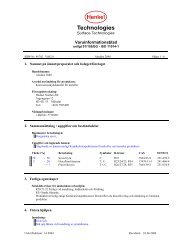
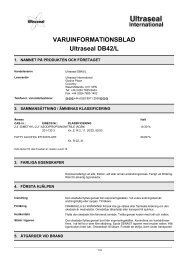
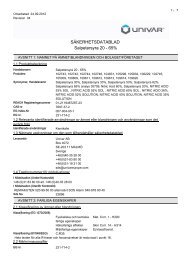


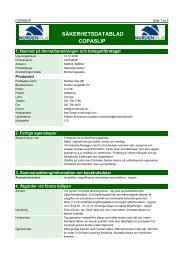
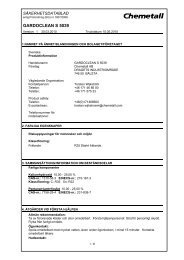
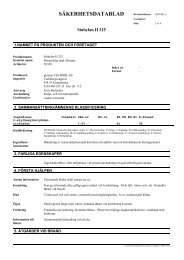
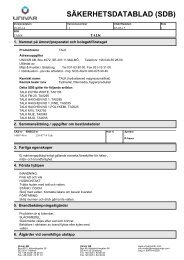
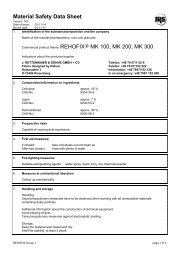
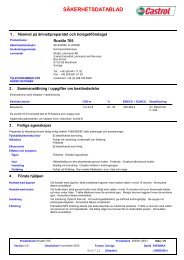
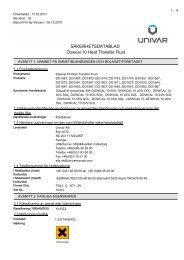

![[EN] - DIESEL FUEL OIL WITH RME - 2007-04-13 - IQ Logistics](https://img.yumpu.com/27279656/1/190x245/en-diesel-fuel-oil-with-rme-2007-04-13-iq-logistics.jpg?quality=85)
